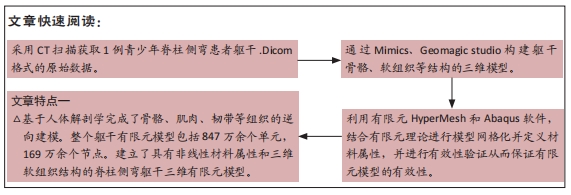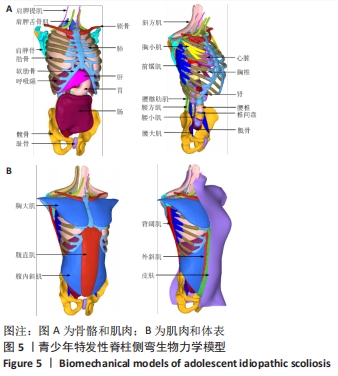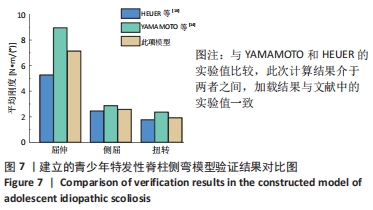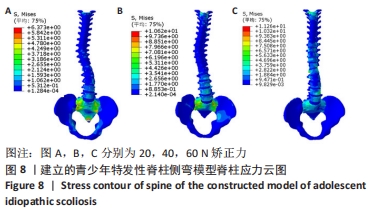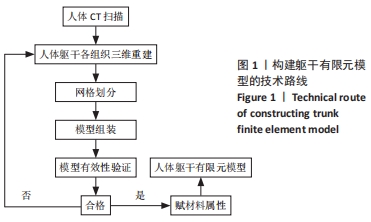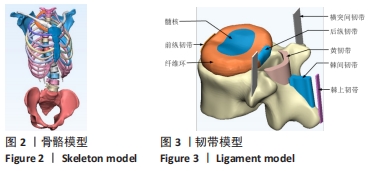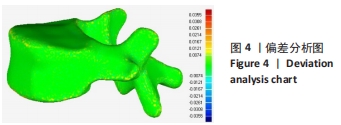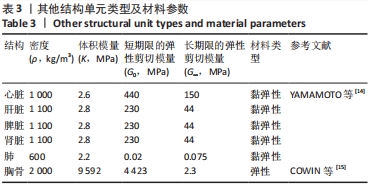[1] ADDAI D, ZARKOS J, BOWEY AJ. Current concepts in the diagnosis and management of adolescent idiopathic scoliosis.Childs Nerv Syst. 2020;36(6):1111-1119.
[2] KUZNIA AL, HERNANDEZ AK, LEE LU.Adolescent Idiopathic Scoliosis: Common Questions and Answers.Am Fam Physician. 2020;101(1):19-23.
[3] 田飞,杨一帆,丁桃.青少年脊柱侧凸的生物力学因素相关性研究[J].中国康复理论与实践,2018,24(4):453-456.
[4] 刘慧,沈国权,张喜林,等.肌肉加载下腰椎间盘突出的有限元研究[J].医用生物力学,2019,34(5):493-499.
[5] 迟鹏飞,王征,吴兵,等.成人退行性脊柱侧凸患者椎旁肌和腰大肌退变的不对称性及其与脊柱-骨盆冠状位参数的关系[J].中国脊柱脊髓杂志,2020,30(1):1-7.
[6] 关天民,陈向禹,朱晔.考虑肌肉因素的腰椎力学计算方法[J].中国组织工程研究,2021,25(27):4307-4311.
[7] HOFFMEISTER BK, SMITH SR, HANDLEY SM,et al. Anisotropy of Young’s modulus of human tibial cortical bone.Med Biol Eng Comput. 2000;38(3):333-338.
[8] SHARMA M, LANGRANA N A, RODRIGUEZ J. Role of Ligaments and Facets in Lumbar Spinal Stability. Spine. 1995;20(8):887-900.
[9] ROBERTS SB, CHEN PH. Elastostatic analysis of the human thoracic skeleton. J Biomech. 1970;3(6):527-545.
[10] CLIN J, AUBIN C, PARENT S, et al. Biomechanical modeling of brace treatment of scoliosis: effects of gravitational loads. Med Biol Eng Comput. 2011;49(7):743-53.
[11] PÉRIÉ D, AUBIN CE, PETIT Y,et al. Personalized biomechanical simulations of orthotic treatment in idiopathic scoliosis. Clin Biomech (Bristol, Avon). 2004;19(2):190-195.
[12] WANG H. Development of a side impact finite element human thoracic model. Thesis, Wayne State University.1995.
[13] 肖智韬. 基于非线性有限元法的人体腰椎强度预测及其在腰椎相关疾病中的应用[D]. 长春:吉林大学,2013.
[14] YAMAMOTO I, PANJABI MM, CRISCO T, et al. Three-dimensional movements of the whole lumbar spine and lumbosacral joint. Spine (Phila Pa 1976). 1989;14(11):1256-1260.
[15] COWIN SC, TELEGA JJ. Bone mechanics handbook. Appl Mech Rev. 2003;56(4):61-63.
[16] CLIN J, CARL-ÉRIC AUBIN, PARENT S, et al. Biomechanical modeling of brace treatment of scoliosis: effects of gravitational loads.Med Biol Eng Comput. 2011;49(7):743-753.
[17] MAC-THIONG JM, PETIT Y, AUBIN CE, et al. Biomechanical evaluation of the Boston brace system for the treatment of adolescent idiopathic scoliosis: relationship between strap tension and brace interface forces.Spine (Phila Pa 1976). 2004;29(1):26-32.
[18] HEUER F, SCHMIDT H, CLAES L, et al. Stepwise reduction of functional spinal structures increase vertebral translation and intradiscal pressure. J Biomech. 2007;40(4):795-803.
[19] 聂文忠. 脊柱胸腰部的生物力学建模与应用研究——中国力学虚拟人的基本问题初探[D]. 上海:上海交通大学,2009.
[20] HURRIYET Y, COSKUN Z, ASLIHAN KO, et al. Prevalence of adolescent idiopathic scoliosis in Turkey: an epidemiological study. Spine J. 2020; 20(6):947-955.
[21] Yang J, Zhang K, Fan H, et al. Development and validation of deep learning algorithms for scoliosis screening using back images. Commun Biol. 2019;2:390.
[22] 王颖.心理干预结合优质护理对特发性脊柱侧弯患者心理状态及医学应对方式的影响[J].心理月刊,2021,16(11):169-170.
[23] 吴春丽,李东方,张晓辉.郑州市儿童青少年脊柱侧弯现状及影响因素[J].华南预防医学,2021,47(5):673-675.
[24] 陈贤艺, 陈扬, 陈显辉,等. 单侧与双侧穿刺PKP术后相邻节段生物力学的三维有限元分析[J]. 中国骨与关节损伤杂志,2020,35(1): 56-58.
[25] SCHULTZ AB, GALANTE JO. A mathematical model for the study of the mechanics of the human vertebral column. J Biomech. 1970;3(4): 405-416.
[26] KING WF, MERTZ HJ. Human Impact Response: Measurement and Simulation. Springer US. 1973.
[27] ANDRIACCHI T, SCHULTZ A, BELYTSCHKO T, et al. A model for studies of mechanical interactions between the human spine and rib cage. J Biomech. 1974;7(6):497-507.
[28] SUNDARAM SH, FENG CC. Finite element analysis of the human thorax. J Biomech. 1977;10(8):505-516.
[29] PLANK GR, KLEINBERGER M, EPPINGER RH. Analytical Investigation of Driver Thoracic Response to Out of Position Airbag Deployment. SAE Technical Papers. 1998;42(18):147-159.
[30] VIVIANI GR, GHISTA DN, LOZADA PJ, et al. Biomechanical Analysis and Simulation of Scoliosis Surgical Correction. Clin Orthop Relat Res. 1986;(208):40-47.
[31] GHISTA DN, VIVIANI GR, SUBBARAJ K, et al. Biomechanical basis of optimal scoliosis surgical correction.J Biomech. 1988;21(2):77-88.
[32] PATWARDHAN AG, GAVIN TM, BUNCH WH, et al. Biomechanical Comparison of the Milwaukee Brace (CTLSO) and the TLSO for Treatment of Idiopathic Scoliosis. J Prosthet Orthot. 1996;8(4):758-760.
[33] DUKE K, AUBIN CE, DANSEREAU J, et al. Computer simulation for the optimization of patient positioning in spinal deformity instrumentation surgery. Med Biol Eng Comput. 2008;46(1):33-41.
[34] 郭立新,张义民,周淑文,等. 人体腰段脊椎建模及其振动趋势预测研究[J]. 系统仿真学报,2009,3(20):6617-6620.
[35] 张治纲,李曙光,范立冬,等. 人体胸部有限元模型研究[J]. 第三军医大学学报,2009,31(6):535-537.
[36] 费琦,李秋军,杨雍,等. 胸腰段骨质疏松性椎体压缩骨折三维有限元模型的建立和应力分析[J]. 中华医学杂志,2010,90(41):2943-2946.
[37] 孙田军. 基于有限元法的六岁儿童乘员腹部碰撞与损伤机理研究[D]. 天津:天津科技大学,2015.
[38] 崔世海,单蕾蕾,李海岩,等. 6岁儿童乘员胸部有限元模型验证及损伤分析[J]. 汽车工程学报,2016,6(6):418-424.
[39] 惠宇,武君胜,鱼滨,等. 脊柱L3~L4段的一体化三维光学模型构建及其生物力学分析[J]. 中国激光,2017,44(7):332-342.
[40] 吴雪海,王星,张少杰,等.有限元模型建立青少年骶椎腰化的验证分析[J].中国组织工程研究,2021,25(27):4283-4288.
[41] 林泽宇,谢雨杉,谢普生,等.腰椎智能医学图像建模系统的构建及精度检验[J].中国临床解剖学杂志,2020, 38(4):444-449.
[42] 张聪, 赵岩, 杜小宇,等. 青少年特发性脊柱侧凸腰主弯患者腰椎-骨盆的生物力学分析[J]. 中国组织工程研究,2020,24(8):1155-1161.
|
